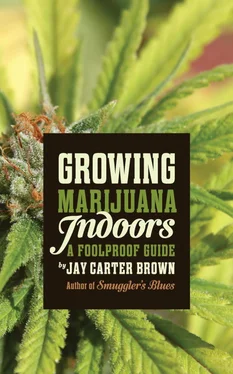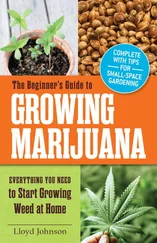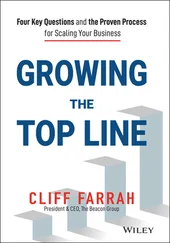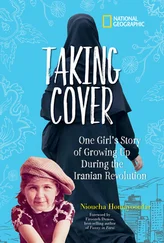You’ll also need a water drum in your grow room. A 30-gallon plastic tank/garbage container holds just the right amount of water for gardens of up to 15 budding plants and 15 to 18 clones. Plastic garbage cans are available at any hardware store. Also pick up a fish tank bubbler to introduce air into the standing water. The bubbler can be purchased at either hydroponics or pet stores. Just drop it into the tank and plug it in. The bubbler runs all the time and does not require a timer.
For starting seeds and clones, I prefer using soil instead of soilless mix because there is enough nutrition in the soil for at least a month, and it is available to the plants with no danger of overfeeding or burning them with too much fertilizer. The best soil comes from hydroponics or gardening stores, but you can also use a brand-name product such as Miracle-Gro soil, which will have all of the necessary trace elements as well as nitrogen, phosphorous, and potassium in the soil. When you find a good soil stick with it.
Always use sterilized soil for your indoor garden to avoid bringing in pests and diseases. When your crop is harvested or your clones are transplanted, do not reuse the leftover soil or drainage rocks. Dump the soil and rocks into a garbage bag and buy fresh soil and drainage rock for the next crop. Toss the garbage bag into a local dumpster, making certain to remove all leaves and branches that might identify the garbage as pot. Place any pot leaves and branches in paper bags, and after they have dried, burn them in your fireplace if you have one. If you don’t have a fireplace, save the leaf debris until you have enough to fill a garbage bag, and dispose of it any way you can. Burn it or bury it or scatter it in the woods. If you burn it, pick a time and place when the fewest people will be around to notice how good it smells.
For growing cannabis in the budding phase, I prefer soilless mediums such as Pro-Mix because it is sterile, light, and clean to use, and it drains well in plant pots. Soilless mixes are often closer than soil to the optimal pH of 7. Regular soil is very messy when wet and is hard to clean up compared with soilless mixes, which don’t leave sludge behind after a wet cleanup. I like to use soilless mixes for blooming plants because I can “push” the plants with a large amount of fertilizer (when necessary) and then clear out the fertilizer with water that drains quickly. Use the most porous soil mix available, and in the case of Pro-Mix use the brand labeled “High Porosity.” The soil substitute mixes are often in large bags that weigh about 30 pounds, but smaller half-size soil mixes are also available. You’ll also need to buy lava rock or sterilized gravel for drainage at the bottom of each pot.
You’ll need two types of fertilizer to bolster plant growth, one for each growth stage: bloom fertilizer to encourage big, healthy buds, and vegetative fertilizer to sponsor healthy growth going into the bud stage. Liquid fertilizers are more expensive, but I prefer them because they mix better than powdered fertilizers. I prefer Heavy Harvest by Nutrilife, but I have also used General Hydroponics plant food. When you find a good fertilizer, keep using it, because once you learn the mixing ratio it is easy to follow. Most good fertilizers contain a few trace elements (micronutrients) in addition to the basic ingredients of N, P, and K. If you buy premium plant food, as opposed to the cheapest plant foods, you’ll get trace elements in a proper ratio to the basic elements. Vegetative plant food formulas are usually higher in nitrogen while flowering formulas are higher in potassium. I don’t recommend the use of “bloom boosters” and “bud blasters” or any of the miracle growth aids sold in garden shops and hydroponics stores with the promise of increased plant yields. Invariably, these growth aids just add to the fertilizers you are already using and toxify the plant with too much of a good thing. When preparing a fertilizer solution use the mixing directions on the package as a guide, but use your salts meter to determine the precise ratio of fertilizer to water. (I’ll cover more on fertilizing in chapter 3.)
A successful marijuana garden starts with good seeds. They can be purchased in Canada at retail outlets, by mail order, or over the Internet. To find the necessary seeds, look up “cannabis seeds” on the Internet and watch the search results pour in. If you order seeds by mail, do not have them sent to where your pot will be grown. Have them sent to a friend, relative, or mail drop address. In some parts of Canada (certainly in major cities) you can find walk-in retail stores that sell seeds.
It is still illegal under U.S. federal law to grow or possess marijuana or to sell seeds. Some states have overruled the federal marijuana laws on possessing and selling marijuana but marijuana seeds are still a gray legal area. Although some U.S. cannabis dispenseries are reported to sell cannabis seeds, they are not generally allowed to be sold in the U.S. at this time. So to obtain seeds in America you will have to shop around a little harder than in Canada. You can try asking about seeds at your local medical marijuana compassion clubs or cannabis dispensaries. (Do not expect positive results over the phone.) Often the attendant there can direct you to someone that can help you even if they are unable to sell you the seeds themselves. Cannabis magazines like High Times or Cannabis Culture have advertisements for mail order seeds, and online sites may offer to mail cannabis seeds into the U.S., or you could try to find seeds or clones from a contact in the weed-growing underworld. Your local hydroponics shops can probably direct you to someone with seeds or clones if they don’t think you’re a narc. Your pot supplier can be the greatest help of all in finding a seed or clone source, although he will ultimately be disappointed to lose your business. Whatever your plan, I do not advise carrying seeds in your clothing or luggage or anywhere on your person when traveling through immigration or customs in any country.
Do not take seeds from a bag of pot you purchased to start your garden. These seeds are often hermaphrodites that grow unwanted male parts along with the desired female parts and are guaranteed to give you the same or worse “seedy bush” weed as the bag that they came from. Seeds from purchased weed might also be from an outdoor variety that does not grow well indoors. What you want for your indoor marijuana garden is a hybrid Sinsemilla plant. Sinsemilla , a Spanish word, means “without seeds.” Seeds can take up half of your marijuana crop and thereby reduce your return by 50 percent. They lower the potency of your pot, and seed pods make the pot taste bitter. The best seeds are large and waxy, though all cannabis seeds will produce marijuana. Visit your local seed store or website to select the seeds that best suit your requirements and tastes.
When you have secured your seeds and are ready to start the growing process, gather:
• saucer
• cotton balls or paper towels
• sterilized potting soil
• potting containers
• pencil
Then,
1. Place seeds on a saucer in thoroughly moistened cotton balls or paper towels for several days until a white root comes out. Keep the cotton balls or paper towels thoroughly moist but not soaked, adding water daily if necessary.
2. Fill one-gallon containers with soil-based growing medium or seed-starting soil.
3. Water soil.
4. Using a pencil-sized object, poke a hole about a half inch deep in the soil.
5. Place the seed in the hole with the root facing down.
6. Gently fill in the gaps around the seeds with loose soil and continue to add soil until the seeds are completely covered with a thin layer of dirt.
Читать дальше












